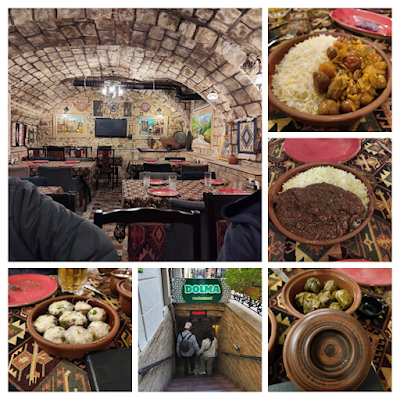Day-2 28/10/24
Left for Gobustan at 10:30 am. Azerbaijan has more mud volcanoes than the total
number of mud volcanoes of all other countries put together. The tourist
vehicle took us to a point from where dirt road starts. We are required to
change vehicle at this spot. The alternate vehicles were small cars with manual
controls and most of them are of Russian make. Drivers were friendly. The
charges were 40 ₼ (AZN: manat) for a car with three passengers. We had two cars
for six of us. It takes around half an hour to reach mud volcanoes. The dirt
track is very challenging and to negotiate ups & downs, twist & turns all
the skill and expertise of seasoned driver is required.
It is an unusual site with dark grey mud, which appears to be boiling
(bubbling) in small to large mounds formed by the overflowing mud. The cause of
bubbling can be Sulphur dioxide or methane gas, but you cannot smell it
anywhere. One of the drivers used lighter to burn the oozing gas from one of
the volcanoes. To our surprise mud was
absolutely cold to touch and had soft, silky feel and became hard as it dried
up. It was difficult to wash the mud from our fingers. One may see videos on
social media of tourists taking mud bath in mud pools, we did not come across
any such large mud pools. We saw small to big mud mounds spread across a very
vast span of arid land but even the big one had comparatively small aperture. Visitors
were carrying the mud in bottles to possibly try mud pack after reaching their
hotels/ place of stay. We did not carry any mud bottles with us.

On the way out from Gobustan Rock Art museum one woman was selling Qutab (Kutab). Qutab is an Azerbaijani dish made from thinly rolled dough that is cooked briefly on a convex griddle known as Saj. It is stuffed flatbread with filling, like stuffed paratha we make. The choice for filling can be unlimited. We had Cheese filling with some fresh herbs served hot. It is a delicacy and a must taste.
We returned to Baku at around 3 pm. We had our late lunch at Dolma restaurant (Dolma is also a name of traditional Azerbaijani dish, a dish of stuffed vegetables or leaves that originated in Turkey, Iran, and other regions. Dolma is typically made with a filling of rice, minced meat, offal- (the heart and other organs of an animal, used as food), seafood, or fruit, wrapped in a vegetable or leaf). All of us were keen on having local Azerbaijani cuisine. Dolma, the place is quite inconspicuous from the road and identified by a small board. We had to walk down few steps to come across long stone corridor with small dining halls accommodating four to six tables with 6-8 chairs each. Ambience was impressive with round colourful glass chandeliers hanging from the ceiling, which was low. The whole appearance is that of well lit, decorated barracks or stone cellars. We were led to our table by waiter traditionally dressed with warm welcoming smile.
We had Tomato soup, Dolma (usually consumed with bread), Lamb pilaff with chestnut, apricots, vegetables and rice, local draft beer, Piti-served in conical earthenware Dobu (pot) and Kunafa for dessert. Dolma, we had, were like round dumplings with minced lamb meat wrapped in mushroom and grape leaves and steamed.
EATING PITI
All you can see in the conical earthenware Dobu (pot) is a lump of lamb fat
floating lugubriously in broth. Don't panic! Before eating anything, start by
tearing up pieces of bread into a separate bowl. Sprinkle with sumac (the
purple condiment you'll see on the table) and then pour the Piti broth over the
top. Eat the resultant soup as a first course. Then transfer the remaining Piti
solids to the dish and mush together using spoon and fork. Yes. Including that
lump of fat. Without it, the dish just will not taste right. Another sprinkling
of sumac and your 'second course' is ready to eat.
Piti, served in conical earthenware Dobu (pot).
The total bill was 150 ₼ for 6 of us. Cheaper than the earlier day and with more
variety.
The waiter’s
name was Nomic. When asked what he was doing he said "it's surprise (pronounced as "suprais"). He had spirit (pronounced as "sprit") lamp to bake the dough. He poured sugar syrup and
allowed it to cook and then spread vanilla ice cream on top and served hot.
It was
Delicious!!
The restaurant was close to the apartment and post lunch we chose to walk back. We walked down the Nizami street. Nice walk, street is like a shopping plaza having outlets of international brands and with quite a few restaurants, many of them served Indian & Pakistani cuisine and staff from those restaurants mostly Pakistani were approaching passing tourists, requesting in Hindi or English to try cuisine from their restaurants. Happy crowd was mingling leisurely around in vacation mood.
It was a
beautiful evening. The day was long and filled with lot of excitement including
the food and beer. We came back to the apartment. After late and heavy lunch
none of us had any appetite for the dinner and preferred to rest.






4 comments:
Nice to have a travelogue. Yes, I agree that the mud volcano you saw seems to be Everest compared to the puddle we were shown during Andaman tour. The culinary part was of more value to a foody like me! Eager to read further.
You have written about the dishes in detail. But I couldn't understand them, except that they delicious and you enjoyed the food.
The photos show the cleanliness of the city, which is SUPERB.
Very well written. I felt as if I was there enjoying the amazing sites. Keep travelling Arun & Hema, and keep sharing your experiences.
Post a Comment